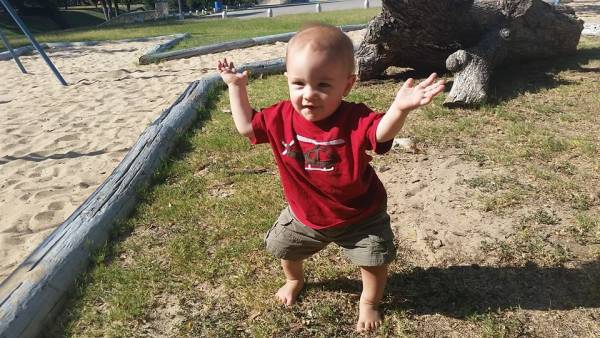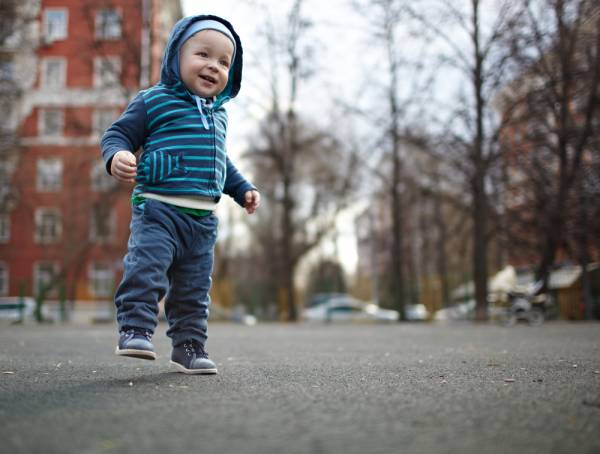Someone once told me the best way to progress in knowledge is to go back to the beginning and look at the fundamentals in a new light. So I figured to learn how to move better, it might be helpful to look at toddlers. What can we learn from these primitive versions of ourselves?
Fortunately, I have a one-year-old at home who just started walking, so it was easy to answer this question. There are a few things I’ve noticed about how he moves, how much he moves, and how he overcomes his movement challenges.
A Lesson in Etymology
The word “toddle” is thought to come from the word “totter,” which is traced back to several verbs, including “sway,” “vacillate,” “tremble,” “shake,” or “hesitate.” In short, if you are not steady on your feet you might be said to “toddle,” regardless of your age or stature.
As adults, we learn to compensate for these small shifts and fluctuations that cause us to unexpectedly faceplant while pursuing food or other desirable objects. But we also learn some shortcuts that might not be optimal in the long run.
4 Movement Lessons From Toddlers
1. Move More
If left to their own will, toddlers will spend most of the day wandering around and sabotaging toilets and other areas that are off-limits. For most of us adults, the problem is that we’re not tottering around and getting into enough trouble. Instead, we’re setting our muscles up for monotony, boredom, and lack of progress.
Movement expert Robert Camacho explained in his article, How to Unlock Your Athletic Potential Through Good Posture:
A large portion of the most common postural issues and also some of the most easily reversible problems stem from sitting down too much, particularly if you’re leaning forward and hunched over a keyboard. When we sit for prolonged periods of time ,the group of muscles responsible for hip flexion (there’s nine of them altogether, but the major ones are your rectus femoris and sartorius which are muscles of your quadriceps and the iliopsoas which is a deep muscle of the hip) are in a shortened position. Spend enough time with these muscles like this and they start to adjust to their new length and even develop a preference for staying that way.
Your body will adjust to any demand you place upon it and all it’s doing by shortening these muscles is helping you maintain the position that you’ve demonstrated you really like being in. Don’t get angry at your hip flexors, they’re just trying to help you.
Further Reading
- I Like to Move It, Move It: The Surprising Thing Missing From Your Training
- Sitting at Your Desk Is Eating Your Muscles
- Book Review: “Move Your DNA”
2. Mobilize
Everyone always talks about how mobile toddlers are. Just the other day I heard an adult say she wished she could still move from standing, to sitting, to squatting as easily as a toddler does. But that’s actually not the mobility lesson I want to convey here. Instead, I’ve been paying attention to the movements my son doesn’t do on a regular basis.
For example, I’ve noticed he rarely puts his arms overhead. It really only happens when he hears Bob Marley playing. My guess is it’s the same for you. Tomorrow, count the number of times you put your arms overhead during the day (when you’re not in the gym).

My son attempting to put his arms overhead. Notice the focus. This pose didn’t last long.
Not only does a lack of mobility increase your risk of injury, but it may also contribute to the dreaded strength plateau. Physical therapist Cassie Dionne explained this in her article, You’re Not Getting Stronger Because You Don’t Know How to Move:
If you have poor mobility – say of your hips, thoracic spine, or shoulders – then you are not going to be able to lift to your full potential. Your body needs to be in the proper position to work most effectively.
Don’t believe me? Try this. Sit down and slouch. Now lift your arms above your head. See how hard that is? And how little range of motion you get? Now sit tall and do the same thing. See how much easier that was? Now imagine adding weight. Of course it is going to take much more effort to lift the weight in a poor body position.
The same is true for our lifts in the gym. Poor mobility means poor and inefficient movement, which translates into us expending far more energy then required. Simply put, this means exerting more effort to lift less weight than you could be capable of.
The lesson toddlers can teach us here is that we all have mobility blind spots to work on. It’s just a natural part of being a moving creature, but when it comes time to perform unnatural movements, it’s something we need to consider.
Further Reading
- Is Mobility Just a Fad?
- 2 Things You’ve Got All Wrong About Movement
- Book Review: “Becoming a Supple Leopard”
3. Stabilize
Everyone who has ever learned anything about fitness knows stability is the foundation of performance in the gym. But if you watch a toddler learning to walk, you’ll notice there’s a big difference between the stability “training” he’s working on and the training you see on BOSU balls in the gym. My toddler doesn’t need to use an unstable object because he is the unstable object.
What does this mean? It means the whole body has to work as a unit to stabilize the toddler and prevent him from tottering. That doesn’t change just because we master the art of balancing on our feet. There’s a big difference between balancing – which is essentially what we’re doing when we stand with bad posture and alignment – and engaging the spine in a stable manner.
Strength coach and senior RKC Josh Henkin explains the importance of this whole-body stability training in his article, Is Stability Training Dumb?
One of the biggest mistakes I made early on in my use of stability training was not realizing there is a difference between the stability of a specific joint versus whole-body stability. Whole-body stability refers to more of the center of mass of the body altering over the base of support, while joint stability is, “the ability to maintain or control joint movement or position.”
Huh? What I was doing wrong with my initial effort with unstable surfaces was actually challenging my ankle and foot stability and thinking it correlated to the stability of my entire body. The problem was that the huge amount of instability coming from my foot and ankle made my body work so hard that it could not create any force or develop strength. What I learned, and hope to share with you, is that whole-body stability is important and needs to be as progressive as load, volume, and any other training variables.
Further Reading
- Load Bearing 101: Lessons From Katy Bowman in How to Hold Your Own Weight
- Do You Know What Your Core Really Is and What It Does?
- Video: A Lesson in Stability for Strength and Fitness

4. Come Clean
Toddlers are what they are. When you catch them cleaning the toilet with your hairbrush, they don’t pretend to be combing their hair. Not so for us adults. We’re sneaky. As physical therapist Lauren Beasley noted in her article, Why Slouching Isn’t the Only Bad Posture, it’s hard to know what the people who walk into our gyms and fitness facilities are actually doing during the day, and that can make things a little tricky.
For example, Lauren explained how overextending the spine in the gym goes hand in hand with slouching in the desk:
Most ironically, many overextenders are also slouchers. Yes, these special folks use two contradictory strategies to achieve one common goal – stability. By day, these guys are probably your average desk-jockeys, slumped over a computer, hanging on their overstretched spine. By night, they transform into badass metal-moving mo-fos, overextending and locking out their spine to press an excessive weight overhead. This is a recipe for disaster. Compressing structures and using muscles incorrectly is exactly how you wear and tear your way to surgical repair.
If you’re that “badass, metal-moving mo-fo” who can barely move in real life, come clean with yourself. If you want to move better and for longer, go for a walk every day and see what it feels like to move your body in this natural way. Re-assess where your real-life fitness stands.
Whether you want to avoid injury or deal with chronic pain, revisiting these basic movement principles is essential. Re-examining your movement habits in light of what your typical toddler spends his or her day doing will be eye-opening. Just remember, there’s no shame in walking a little bit later than the status quo, especially if the extra time spent makes you better in the long run.
Photo 1 and 3 courtesy of Shutterstock.






